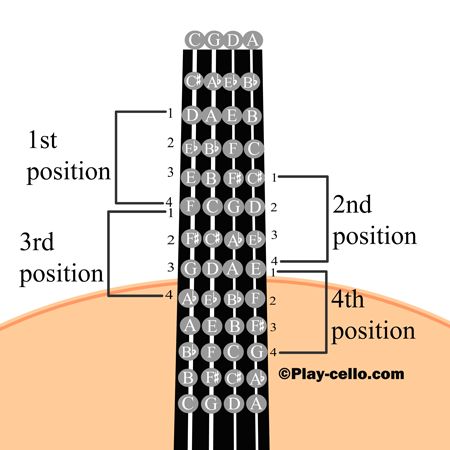I spend lots of time in first position. I think it’s good to do that, to be comfortable, since we spend so much time there. But there are times when you have to get out of that comfort zone and move up the fingerboard.
For one thing, there are notes up there (or down there, depending on your perspective[ I call it up since the notes go higher]) that can’t be played unless you move up the fingerboard. So it helps to know where the notes are. Here’s a pic that gives you a visual:

The only thing I don’t like about this pictures is that it neglects that fact that the space between fingers gets smaller as you move up the fingerboard. But you knew that.
One reason I like the cello so much is that you can often find the same note on 2 or 3 different strings so you have options about playing a passage. Choice is a nice thing. So how do you get from first position to second? or third, fourth, fifth… Well, you shift. What I’ve learned is that the shift is propelled by your arm. Your fingers don’t “tow” your arm all over the cello. Your arm puts you in position, and all the fingers have to do is type. Accurately. There are lots of thoughts about shifting. This is one of them. Here are some more:
Think about shifting from position to position, rather than from note to note. Keep the speed of the shift SLOW.
I like to shift on the finger that is down. Say you want to shift from first position to fourth, because you want to play an A on the D string. (Because you’d like to vibrate the A.) Your first finger is on the E. Your arm does a “wind up”, creating forward momentum, and you slowly move your arm up to fourth position, landing your first finger on the A. Then you do the reverse and go back to the E. And repeat this many times. You go forth and back because you want to get practice doing both shifts. You do it many times because you’re teaching your arm what the distance is from first to fourth position on your cello. Those muscles in your arm will learn and remember! That’s the exciting part. Your brain doesn’t need to tell them. Muscles are smart.
There’s lots more to shifting, but that’s a good start.
David B Teague says:
THANK you for the picture and the remarks. Bass in 5ths positions are the same as the Cello. I never learned the bass in 4ths (aka Simandl) positions. This will help in understanding cello books. I was srprised how many don’t make this notion clear
The first finger moves through the successive positions on the notes of an A major scale:
Open A, B (1st pos.), C# (2nd pos), D (3rd pos), E(4th p) etc.
I’m fuzzy on the notion of intermediate positions too. I’m sure you’ll make them clear too, in time.
nancymack says:
Hi David. I think by “intermediate positions” you mean Upper Second, Extended Second, Lower Third, Lower Second, Upper Third and Extended Third? I find all of these so confusing! But here’s how I try to compartmentalize it (on the “A” string):
Upper Second- 1 on C#, 2 on D
Extended Second- 1 on C, 2 on D
Lower Third- 1 on D, 2 on D#
Lower Second- 1 on C, 2 on C#
Upper Third- 1 on D#, 2 on E
Extended Third- 1 on D, 2 on E
Could this be any more confusing? Get Rick Mooney’s Position Pieces for Cello to make it manageable!
David B Teague says:
I wish there were a “Like” etc button here. This really helps. Ric Mooney’s work is always great, and I’ll look at “Position Pieces”.